A Literature Review on Best Practices for Automatic Software Updates
VerifiedAdded on 2023/04/19
|15
|3745
|142
Literature Review
AI Summary
This literature review examines the best practices for automatic software updates, focusing on the challenges users face when updating security patches. It covers various aspects, including the background of automatic updates, research aims and objectives, research questions, and a problem statement. The review delves into the benefits and constraints of automatic updates, highlighting issues such as IP spoofing risks, privacy and security threats, and compatibility problems. It also discusses the importance of security patches in addressing vulnerabilities and improving software performance. The review references multiple studies to provide a comprehensive overview of the topic, touching on patch management, cybersecurity, and the complexities of installing security patches. The research methodology includes interpretivism philosophy and secondary data analysis from peer-reviewed articles.
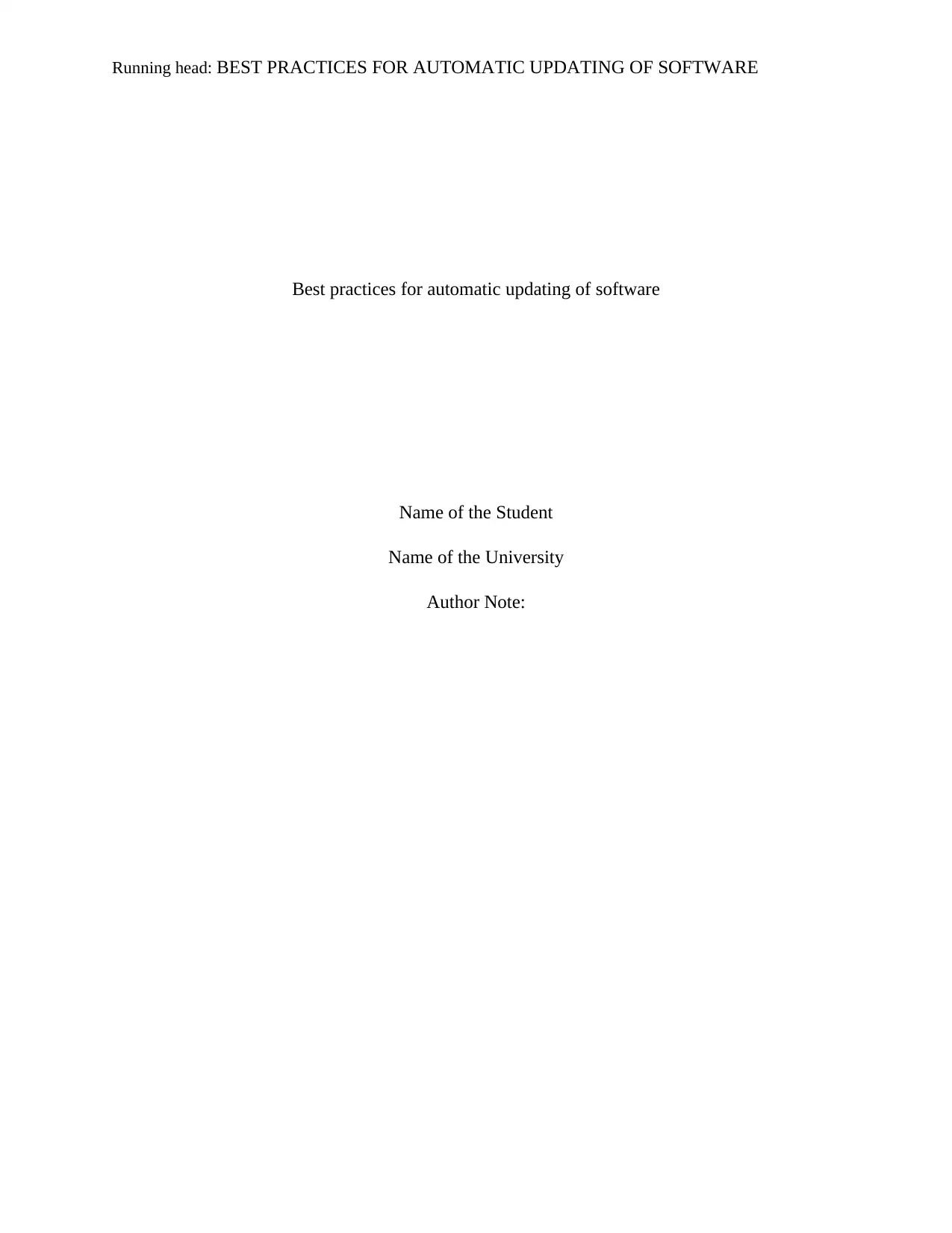
Running head: BEST PRACTICES FOR AUTOMATIC UPDATING OF SOFTWARE
Best practices for automatic updating of software
Name of the Student
Name of the University
Author Note:
Best practices for automatic updating of software
Name of the Student
Name of the University
Author Note:
Paraphrase This Document
Need a fresh take? Get an instant paraphrase of this document with our AI Paraphraser

1BEST PRACTICES FOR AUTOMATIC UPDATING OF SOFTWARE
Executive Summary
The notable objective of this paper is to focus on the difficulties faced by the users while
updating the security patches in their computer systems. This research proposal will be having
numerous sections and sub sections, each of them is very much important to find the
effectiveness of the paper. The introduction unit will be having four sub sections stating the
background of the study, research aims and objectives, research questions and problem
statement. The following unit of the paper will be presenting the literature review. The paper will
be concluding with the research methodology sections which will be again subdivided into
sections such as research philosophy, research design, data collection procedure, sampling
method used in the paper, ethical considerations of the paper, type of data analysis and the
limitations of the study.
Executive Summary
The notable objective of this paper is to focus on the difficulties faced by the users while
updating the security patches in their computer systems. This research proposal will be having
numerous sections and sub sections, each of them is very much important to find the
effectiveness of the paper. The introduction unit will be having four sub sections stating the
background of the study, research aims and objectives, research questions and problem
statement. The following unit of the paper will be presenting the literature review. The paper will
be concluding with the research methodology sections which will be again subdivided into
sections such as research philosophy, research design, data collection procedure, sampling
method used in the paper, ethical considerations of the paper, type of data analysis and the
limitations of the study.
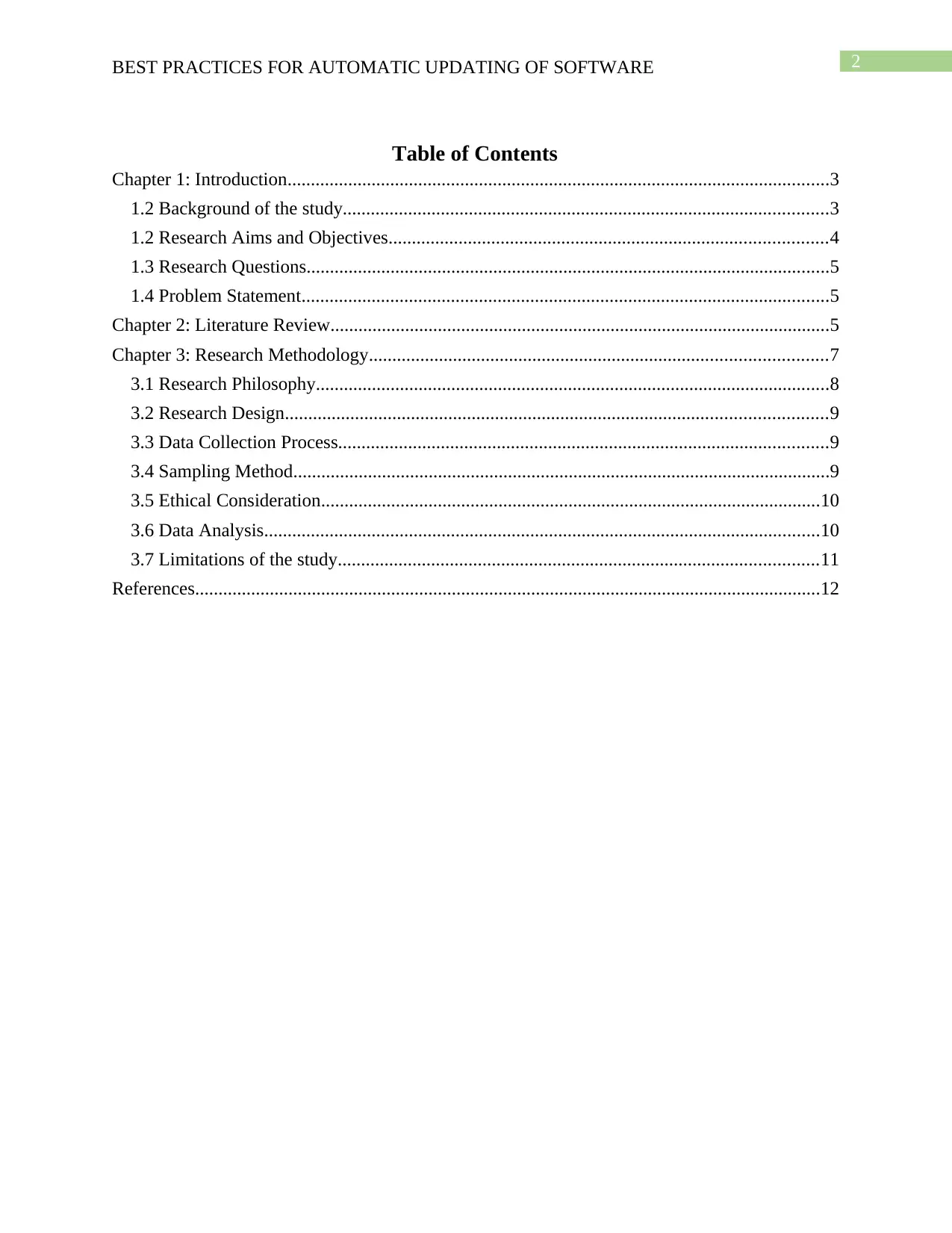
2BEST PRACTICES FOR AUTOMATIC UPDATING OF SOFTWARE
Table of Contents
Chapter 1: Introduction....................................................................................................................3
1.2 Background of the study........................................................................................................3
1.2 Research Aims and Objectives..............................................................................................4
1.3 Research Questions................................................................................................................5
1.4 Problem Statement.................................................................................................................5
Chapter 2: Literature Review...........................................................................................................5
Chapter 3: Research Methodology..................................................................................................7
3.1 Research Philosophy..............................................................................................................8
3.2 Research Design....................................................................................................................9
3.3 Data Collection Process.........................................................................................................9
3.4 Sampling Method...................................................................................................................9
3.5 Ethical Consideration...........................................................................................................10
3.6 Data Analysis.......................................................................................................................10
3.7 Limitations of the study.......................................................................................................11
References......................................................................................................................................12
Table of Contents
Chapter 1: Introduction....................................................................................................................3
1.2 Background of the study........................................................................................................3
1.2 Research Aims and Objectives..............................................................................................4
1.3 Research Questions................................................................................................................5
1.4 Problem Statement.................................................................................................................5
Chapter 2: Literature Review...........................................................................................................5
Chapter 3: Research Methodology..................................................................................................7
3.1 Research Philosophy..............................................................................................................8
3.2 Research Design....................................................................................................................9
3.3 Data Collection Process.........................................................................................................9
3.4 Sampling Method...................................................................................................................9
3.5 Ethical Consideration...........................................................................................................10
3.6 Data Analysis.......................................................................................................................10
3.7 Limitations of the study.......................................................................................................11
References......................................................................................................................................12
⊘ This is a preview!⊘
Do you want full access?
Subscribe today to unlock all pages.

Trusted by 1+ million students worldwide

3BEST PRACTICES FOR AUTOMATIC UPDATING OF SOFTWARE
Chapter 1: Introduction
The notable determination of this research proposal is to identify the best practices for
automatic updating of the software so that the users of the software are happy as the security
patches are installed quickly for the software.
There are lots of issues associated with the automatic software update procedure such as
the risks coming from IP spoofing, privacy and security threats during the automatic updating
procedure, compatibility of the computer systems and the security patches (Rac-Lubashevsky
and Kessler 2016). Losing track of the changes in the software after the installation procedure
and the slow installation of the security patches are the other significant issues associated with
the use of the automatic updating procedure. The following unit of the paper will be discussing
different aspects of the automatic software updating procedures and the impact of using security
patches.
1.2 Background of the study
The automatic software updating is very much beneficial for the users of the software as
it helps them to deal with adverse conditions such as a security risk coming from a cyber-security
attack like Ransomware. The digital safety of the system is maintained by updating the security
patches (Neumann et al. 2016). However, the automatic updating procedure can have a
significant negative impact on the installation procedure of the security patches (Jin et al. 2017).
The updating procedure can be both manually selected by the users of the system at the same
time it can be done automatically. The security patches are important not only to deal with the
security issues but at the same time it can be said that vulnerabilities or the limitations of the
software are also removed after the installation procedure security patches (Mitra and
Chapter 1: Introduction
The notable determination of this research proposal is to identify the best practices for
automatic updating of the software so that the users of the software are happy as the security
patches are installed quickly for the software.
There are lots of issues associated with the automatic software update procedure such as
the risks coming from IP spoofing, privacy and security threats during the automatic updating
procedure, compatibility of the computer systems and the security patches (Rac-Lubashevsky
and Kessler 2016). Losing track of the changes in the software after the installation procedure
and the slow installation of the security patches are the other significant issues associated with
the use of the automatic updating procedure. The following unit of the paper will be discussing
different aspects of the automatic software updating procedures and the impact of using security
patches.
1.2 Background of the study
The automatic software updating is very much beneficial for the users of the software as
it helps them to deal with adverse conditions such as a security risk coming from a cyber-security
attack like Ransomware. The digital safety of the system is maintained by updating the security
patches (Neumann et al. 2016). However, the automatic updating procedure can have a
significant negative impact on the installation procedure of the security patches (Jin et al. 2017).
The updating procedure can be both manually selected by the users of the system at the same
time it can be done automatically. The security patches are important not only to deal with the
security issues but at the same time it can be said that vulnerabilities or the limitations of the
software are also removed after the installation procedure security patches (Mitra and
Paraphrase This Document
Need a fresh take? Get an instant paraphrase of this document with our AI Paraphraser
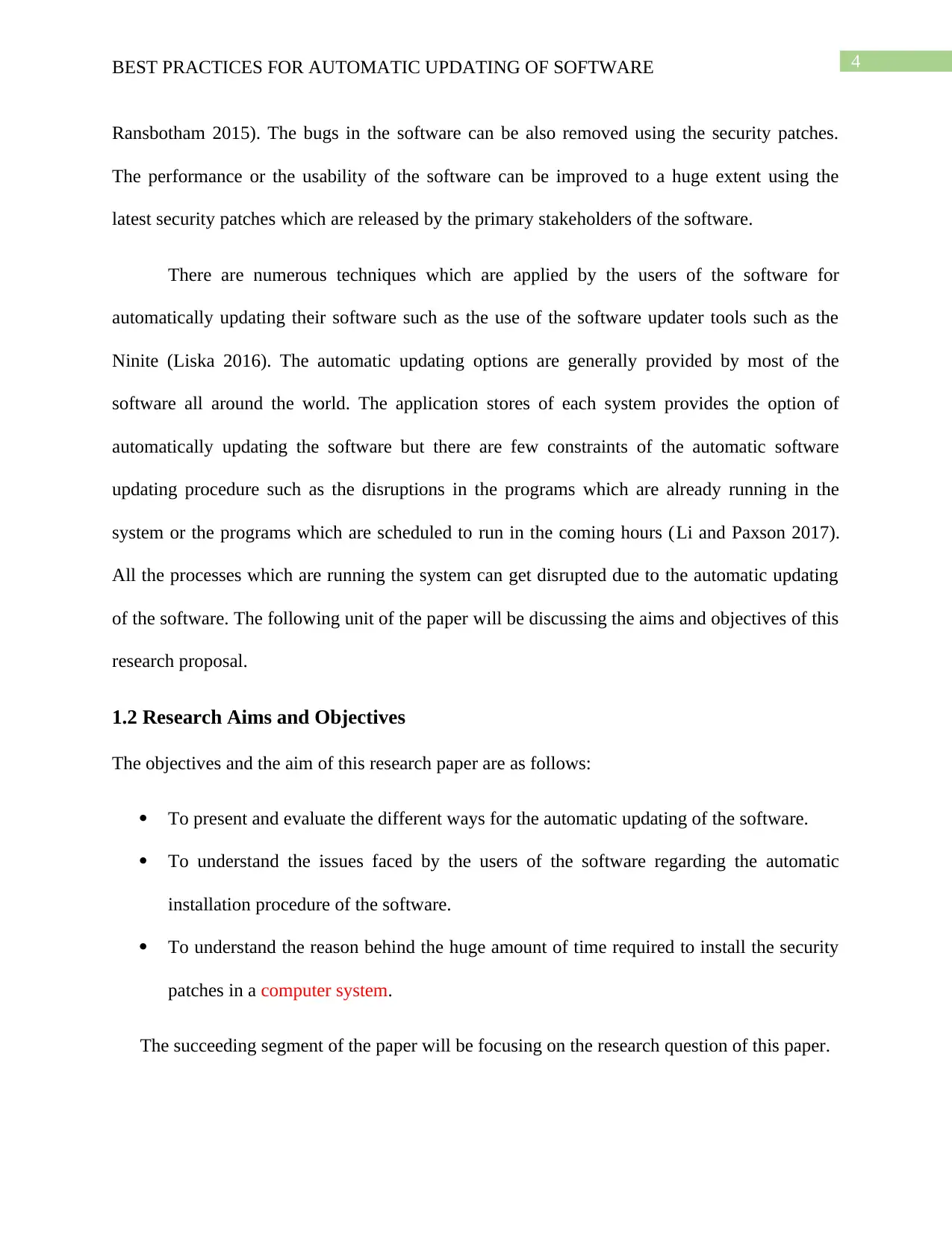
4BEST PRACTICES FOR AUTOMATIC UPDATING OF SOFTWARE
Ransbotham 2015). The bugs in the software can be also removed using the security patches.
The performance or the usability of the software can be improved to a huge extent using the
latest security patches which are released by the primary stakeholders of the software.
There are numerous techniques which are applied by the users of the software for
automatically updating their software such as the use of the software updater tools such as the
Ninite (Liska 2016). The automatic updating options are generally provided by most of the
software all around the world. The application stores of each system provides the option of
automatically updating the software but there are few constraints of the automatic software
updating procedure such as the disruptions in the programs which are already running in the
system or the programs which are scheduled to run in the coming hours (Li and Paxson 2017).
All the processes which are running the system can get disrupted due to the automatic updating
of the software. The following unit of the paper will be discussing the aims and objectives of this
research proposal.
1.2 Research Aims and Objectives
The objectives and the aim of this research paper are as follows:
To present and evaluate the different ways for the automatic updating of the software.
To understand the issues faced by the users of the software regarding the automatic
installation procedure of the software.
To understand the reason behind the huge amount of time required to install the security
patches in a computer system.
The succeeding segment of the paper will be focusing on the research question of this paper.
Ransbotham 2015). The bugs in the software can be also removed using the security patches.
The performance or the usability of the software can be improved to a huge extent using the
latest security patches which are released by the primary stakeholders of the software.
There are numerous techniques which are applied by the users of the software for
automatically updating their software such as the use of the software updater tools such as the
Ninite (Liska 2016). The automatic updating options are generally provided by most of the
software all around the world. The application stores of each system provides the option of
automatically updating the software but there are few constraints of the automatic software
updating procedure such as the disruptions in the programs which are already running in the
system or the programs which are scheduled to run in the coming hours (Li and Paxson 2017).
All the processes which are running the system can get disrupted due to the automatic updating
of the software. The following unit of the paper will be discussing the aims and objectives of this
research proposal.
1.2 Research Aims and Objectives
The objectives and the aim of this research paper are as follows:
To present and evaluate the different ways for the automatic updating of the software.
To understand the issues faced by the users of the software regarding the automatic
installation procedure of the software.
To understand the reason behind the huge amount of time required to install the security
patches in a computer system.
The succeeding segment of the paper will be focusing on the research question of this paper.
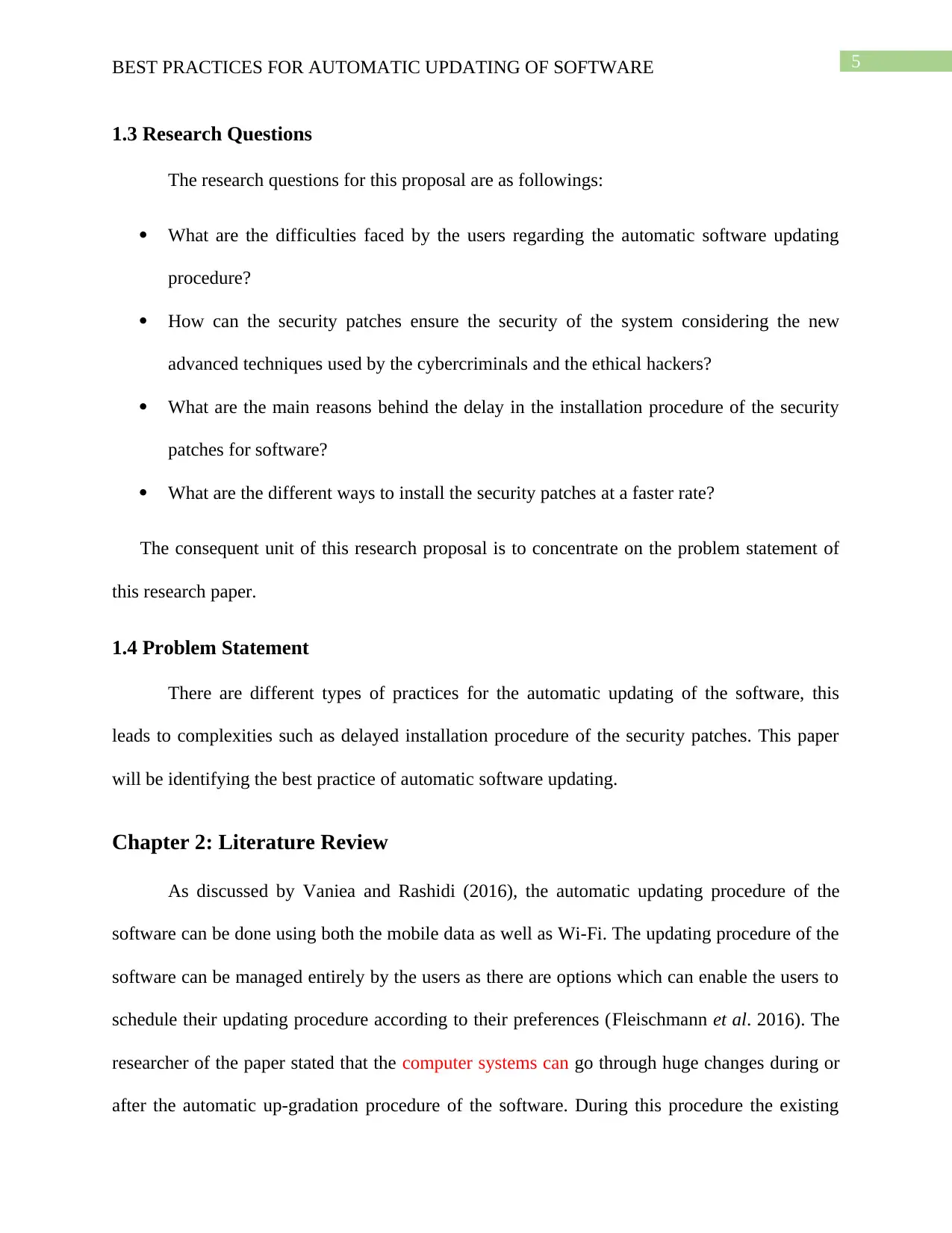
5BEST PRACTICES FOR AUTOMATIC UPDATING OF SOFTWARE
1.3 Research Questions
The research questions for this proposal are as followings:
What are the difficulties faced by the users regarding the automatic software updating
procedure?
How can the security patches ensure the security of the system considering the new
advanced techniques used by the cybercriminals and the ethical hackers?
What are the main reasons behind the delay in the installation procedure of the security
patches for software?
What are the different ways to install the security patches at a faster rate?
The consequent unit of this research proposal is to concentrate on the problem statement of
this research paper.
1.4 Problem Statement
There are different types of practices for the automatic updating of the software, this
leads to complexities such as delayed installation procedure of the security patches. This paper
will be identifying the best practice of automatic software updating.
Chapter 2: Literature Review
As discussed by Vaniea and Rashidi (2016), the automatic updating procedure of the
software can be done using both the mobile data as well as Wi-Fi. The updating procedure of the
software can be managed entirely by the users as there are options which can enable the users to
schedule their updating procedure according to their preferences (Fleischmann et al. 2016). The
researcher of the paper stated that the computer systems can go through huge changes during or
after the automatic up-gradation procedure of the software. During this procedure the existing
1.3 Research Questions
The research questions for this proposal are as followings:
What are the difficulties faced by the users regarding the automatic software updating
procedure?
How can the security patches ensure the security of the system considering the new
advanced techniques used by the cybercriminals and the ethical hackers?
What are the main reasons behind the delay in the installation procedure of the security
patches for software?
What are the different ways to install the security patches at a faster rate?
The consequent unit of this research proposal is to concentrate on the problem statement of
this research paper.
1.4 Problem Statement
There are different types of practices for the automatic updating of the software, this
leads to complexities such as delayed installation procedure of the security patches. This paper
will be identifying the best practice of automatic software updating.
Chapter 2: Literature Review
As discussed by Vaniea and Rashidi (2016), the automatic updating procedure of the
software can be done using both the mobile data as well as Wi-Fi. The updating procedure of the
software can be managed entirely by the users as there are options which can enable the users to
schedule their updating procedure according to their preferences (Fleischmann et al. 2016). The
researcher of the paper stated that the computer systems can go through huge changes during or
after the automatic up-gradation procedure of the software. During this procedure the existing
⊘ This is a preview!⊘
Do you want full access?
Subscribe today to unlock all pages.

Trusted by 1+ million students worldwide
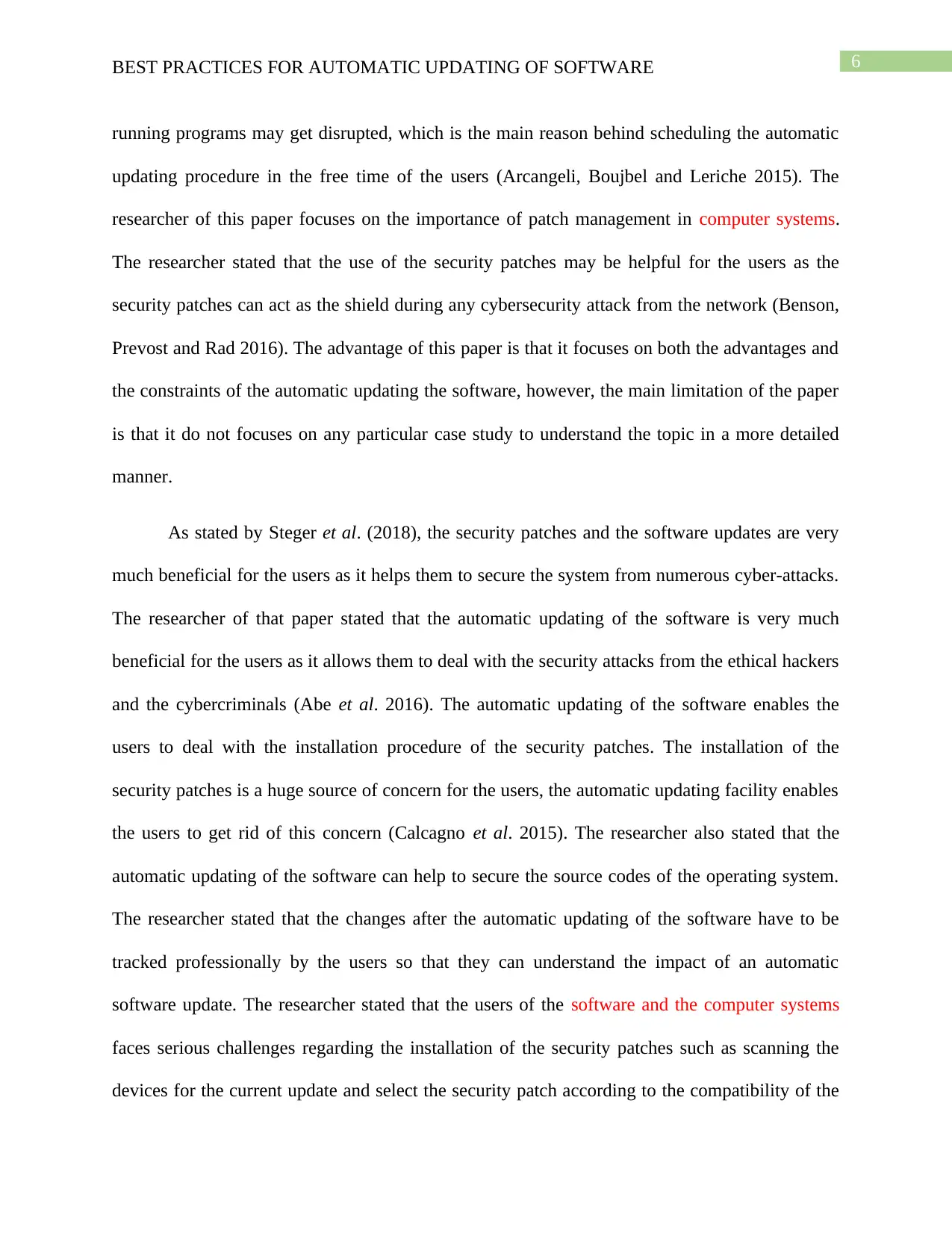
6BEST PRACTICES FOR AUTOMATIC UPDATING OF SOFTWARE
running programs may get disrupted, which is the main reason behind scheduling the automatic
updating procedure in the free time of the users (Arcangeli, Boujbel and Leriche 2015). The
researcher of this paper focuses on the importance of patch management in computer systems.
The researcher stated that the use of the security patches may be helpful for the users as the
security patches can act as the shield during any cybersecurity attack from the network (Benson,
Prevost and Rad 2016). The advantage of this paper is that it focuses on both the advantages and
the constraints of the automatic updating the software, however, the main limitation of the paper
is that it do not focuses on any particular case study to understand the topic in a more detailed
manner.
As stated by Steger et al. (2018), the security patches and the software updates are very
much beneficial for the users as it helps them to secure the system from numerous cyber-attacks.
The researcher of that paper stated that the automatic updating of the software is very much
beneficial for the users as it allows them to deal with the security attacks from the ethical hackers
and the cybercriminals (Abe et al. 2016). The automatic updating of the software enables the
users to deal with the installation procedure of the security patches. The installation of the
security patches is a huge source of concern for the users, the automatic updating facility enables
the users to get rid of this concern (Calcagno et al. 2015). The researcher also stated that the
automatic updating of the software can help to secure the source codes of the operating system.
The researcher stated that the changes after the automatic updating of the software have to be
tracked professionally by the users so that they can understand the impact of an automatic
software update. The researcher stated that the users of the software and the computer systems
faces serious challenges regarding the installation of the security patches such as scanning the
devices for the current update and select the security patch according to the compatibility of the
running programs may get disrupted, which is the main reason behind scheduling the automatic
updating procedure in the free time of the users (Arcangeli, Boujbel and Leriche 2015). The
researcher of this paper focuses on the importance of patch management in computer systems.
The researcher stated that the use of the security patches may be helpful for the users as the
security patches can act as the shield during any cybersecurity attack from the network (Benson,
Prevost and Rad 2016). The advantage of this paper is that it focuses on both the advantages and
the constraints of the automatic updating the software, however, the main limitation of the paper
is that it do not focuses on any particular case study to understand the topic in a more detailed
manner.
As stated by Steger et al. (2018), the security patches and the software updates are very
much beneficial for the users as it helps them to secure the system from numerous cyber-attacks.
The researcher of that paper stated that the automatic updating of the software is very much
beneficial for the users as it allows them to deal with the security attacks from the ethical hackers
and the cybercriminals (Abe et al. 2016). The automatic updating of the software enables the
users to deal with the installation procedure of the security patches. The installation of the
security patches is a huge source of concern for the users, the automatic updating facility enables
the users to get rid of this concern (Calcagno et al. 2015). The researcher also stated that the
automatic updating of the software can help to secure the source codes of the operating system.
The researcher stated that the changes after the automatic updating of the software have to be
tracked professionally by the users so that they can understand the impact of an automatic
software update. The researcher stated that the users of the software and the computer systems
faces serious challenges regarding the installation of the security patches such as scanning the
devices for the current update and select the security patch according to the compatibility of the
Paraphrase This Document
Need a fresh take? Get an instant paraphrase of this document with our AI Paraphraser

7BEST PRACTICES FOR AUTOMATIC UPDATING OF SOFTWARE
device (Clarke et al. 2016). The researcher stated that the servicing stack update before the
manual software updating procedure is the other problem for the users which is not there in the
automatic updating procedure (Avery and Spafford 2017). The paper have described all the
probable benefits of automatic updating procedure, the most significant limitation of the paper is
that it Thus the paper helps in understanding that the automatic updating of the software is much
more facilitative than the manual dating the procedure.
As mentioned by Stankovic et al. (2019), users face huge complexities while installing
the security patches of software. The researcher of this paper classified the complexities into
numerous categories which are very much useful for the readers to understand the topic in a
detailed manner such as the legacy vulnerabilities such as the compatibility issues. The
researcher stated that operations of the devices may get disrupted due to the manual installation
procedure of the security patches (Dumitras 2017). The concept of security patch management
has been explained briefly in this paper with the help of a case study by the researcher.
According to the researcher, patch education can be very much useful for the users of the
computer systems as it will help them to deal with difficulties of installing security patches
(Sarabi et al. 2017). The researcher stated that the use of the heterogeneous OS platform can be
the best practise for managing the security patches. The detailed patch deployment is very much
important for maintaining the security of the computer systems as stated by the researcher. The
most significant contribution of the paper is that it focuses on technical difficulties of the
installation procedure of the security patches, there are negligible limitations of this paper. The
following unit of the proposal will be presenting the research methodology.
device (Clarke et al. 2016). The researcher stated that the servicing stack update before the
manual software updating procedure is the other problem for the users which is not there in the
automatic updating procedure (Avery and Spafford 2017). The paper have described all the
probable benefits of automatic updating procedure, the most significant limitation of the paper is
that it Thus the paper helps in understanding that the automatic updating of the software is much
more facilitative than the manual dating the procedure.
As mentioned by Stankovic et al. (2019), users face huge complexities while installing
the security patches of software. The researcher of this paper classified the complexities into
numerous categories which are very much useful for the readers to understand the topic in a
detailed manner such as the legacy vulnerabilities such as the compatibility issues. The
researcher stated that operations of the devices may get disrupted due to the manual installation
procedure of the security patches (Dumitras 2017). The concept of security patch management
has been explained briefly in this paper with the help of a case study by the researcher.
According to the researcher, patch education can be very much useful for the users of the
computer systems as it will help them to deal with difficulties of installing security patches
(Sarabi et al. 2017). The researcher stated that the use of the heterogeneous OS platform can be
the best practise for managing the security patches. The detailed patch deployment is very much
important for maintaining the security of the computer systems as stated by the researcher. The
most significant contribution of the paper is that it focuses on technical difficulties of the
installation procedure of the security patches, there are negligible limitations of this paper. The
following unit of the proposal will be presenting the research methodology.
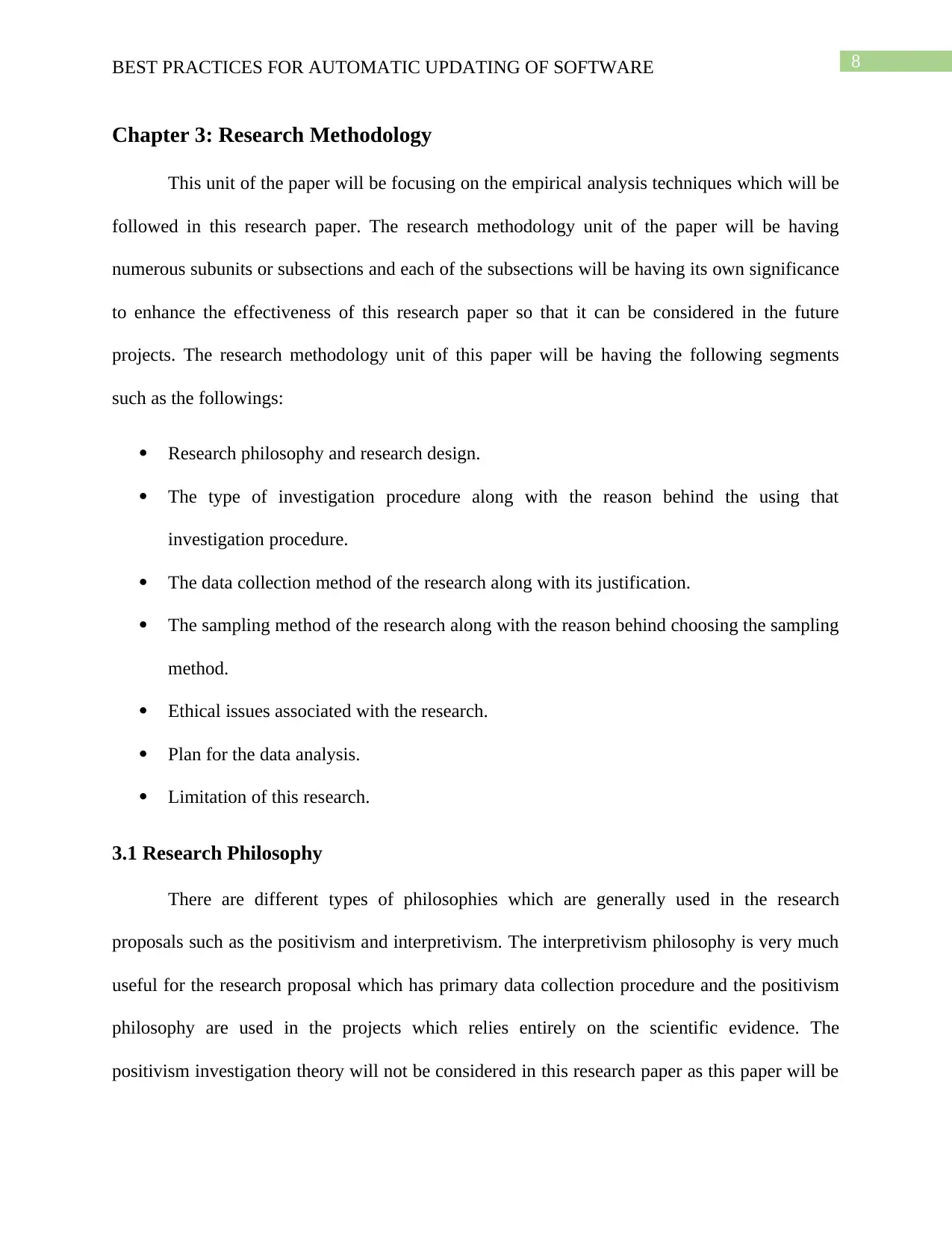
8BEST PRACTICES FOR AUTOMATIC UPDATING OF SOFTWARE
Chapter 3: Research Methodology
This unit of the paper will be focusing on the empirical analysis techniques which will be
followed in this research paper. The research methodology unit of the paper will be having
numerous subunits or subsections and each of the subsections will be having its own significance
to enhance the effectiveness of this research paper so that it can be considered in the future
projects. The research methodology unit of this paper will be having the following segments
such as the followings:
Research philosophy and research design.
The type of investigation procedure along with the reason behind the using that
investigation procedure.
The data collection method of the research along with its justification.
The sampling method of the research along with the reason behind choosing the sampling
method.
Ethical issues associated with the research.
Plan for the data analysis.
Limitation of this research.
3.1 Research Philosophy
There are different types of philosophies which are generally used in the research
proposals such as the positivism and interpretivism. The interpretivism philosophy is very much
useful for the research proposal which has primary data collection procedure and the positivism
philosophy are used in the projects which relies entirely on the scientific evidence. The
positivism investigation theory will not be considered in this research paper as this paper will be
Chapter 3: Research Methodology
This unit of the paper will be focusing on the empirical analysis techniques which will be
followed in this research paper. The research methodology unit of the paper will be having
numerous subunits or subsections and each of the subsections will be having its own significance
to enhance the effectiveness of this research paper so that it can be considered in the future
projects. The research methodology unit of this paper will be having the following segments
such as the followings:
Research philosophy and research design.
The type of investigation procedure along with the reason behind the using that
investigation procedure.
The data collection method of the research along with its justification.
The sampling method of the research along with the reason behind choosing the sampling
method.
Ethical issues associated with the research.
Plan for the data analysis.
Limitation of this research.
3.1 Research Philosophy
There are different types of philosophies which are generally used in the research
proposals such as the positivism and interpretivism. The interpretivism philosophy is very much
useful for the research proposal which has primary data collection procedure and the positivism
philosophy are used in the projects which relies entirely on the scientific evidence. The
positivism investigation theory will not be considered in this research paper as this paper will be
⊘ This is a preview!⊘
Do you want full access?
Subscribe today to unlock all pages.

Trusted by 1+ million students worldwide

9BEST PRACTICES FOR AUTOMATIC UPDATING OF SOFTWARE
considering only secondary data collection procedure from peer-reviewed scholarly articles.
Thus the paper will be considering the interpretivism philosophy as the data analysis will be
done on the peer-reviewed journals.
3.2 Research Design
Three different categories of research design which are usually used in the research
proposal such as the exploratory research design, explanatory research design and the descriptive
research design. The explanatory research design is used in the research proposal which focuses
on a topic which is not focused by any other researchers, the exploratory research designs are
used in research proposals which needs clarifying an issue using theoretical or hypothetical
ideologies. The descriptive research designs are used in the research proposal where data are
collected from primary resources. Considering all the three different types of research designs it
can be said that the exploratory research designs will be considered in this research proposal.
3.3 Data Collection Process
There are two different categories of data collection procedure for the research paper
such as the primary data collection and the secondary data collection procedure. The primary
data collection procedure is the process of collection of data from personal interview, survey or
group discussion. The secondary data collection procedure is the procedure of collection of data
from secondary sources such as the peer-reviewed scholarly articles. Both the two types of data
collection procedure have its own significance in providing reliability to the research proposal.
Considering both the two types of data collection procedures it can be said that this research
proposal will be considering the secondary data collection.
considering only secondary data collection procedure from peer-reviewed scholarly articles.
Thus the paper will be considering the interpretivism philosophy as the data analysis will be
done on the peer-reviewed journals.
3.2 Research Design
Three different categories of research design which are usually used in the research
proposal such as the exploratory research design, explanatory research design and the descriptive
research design. The explanatory research design is used in the research proposal which focuses
on a topic which is not focused by any other researchers, the exploratory research designs are
used in research proposals which needs clarifying an issue using theoretical or hypothetical
ideologies. The descriptive research designs are used in the research proposal where data are
collected from primary resources. Considering all the three different types of research designs it
can be said that the exploratory research designs will be considered in this research proposal.
3.3 Data Collection Process
There are two different categories of data collection procedure for the research paper
such as the primary data collection and the secondary data collection procedure. The primary
data collection procedure is the process of collection of data from personal interview, survey or
group discussion. The secondary data collection procedure is the procedure of collection of data
from secondary sources such as the peer-reviewed scholarly articles. Both the two types of data
collection procedure have its own significance in providing reliability to the research proposal.
Considering both the two types of data collection procedures it can be said that this research
proposal will be considering the secondary data collection.
Paraphrase This Document
Need a fresh take? Get an instant paraphrase of this document with our AI Paraphraser
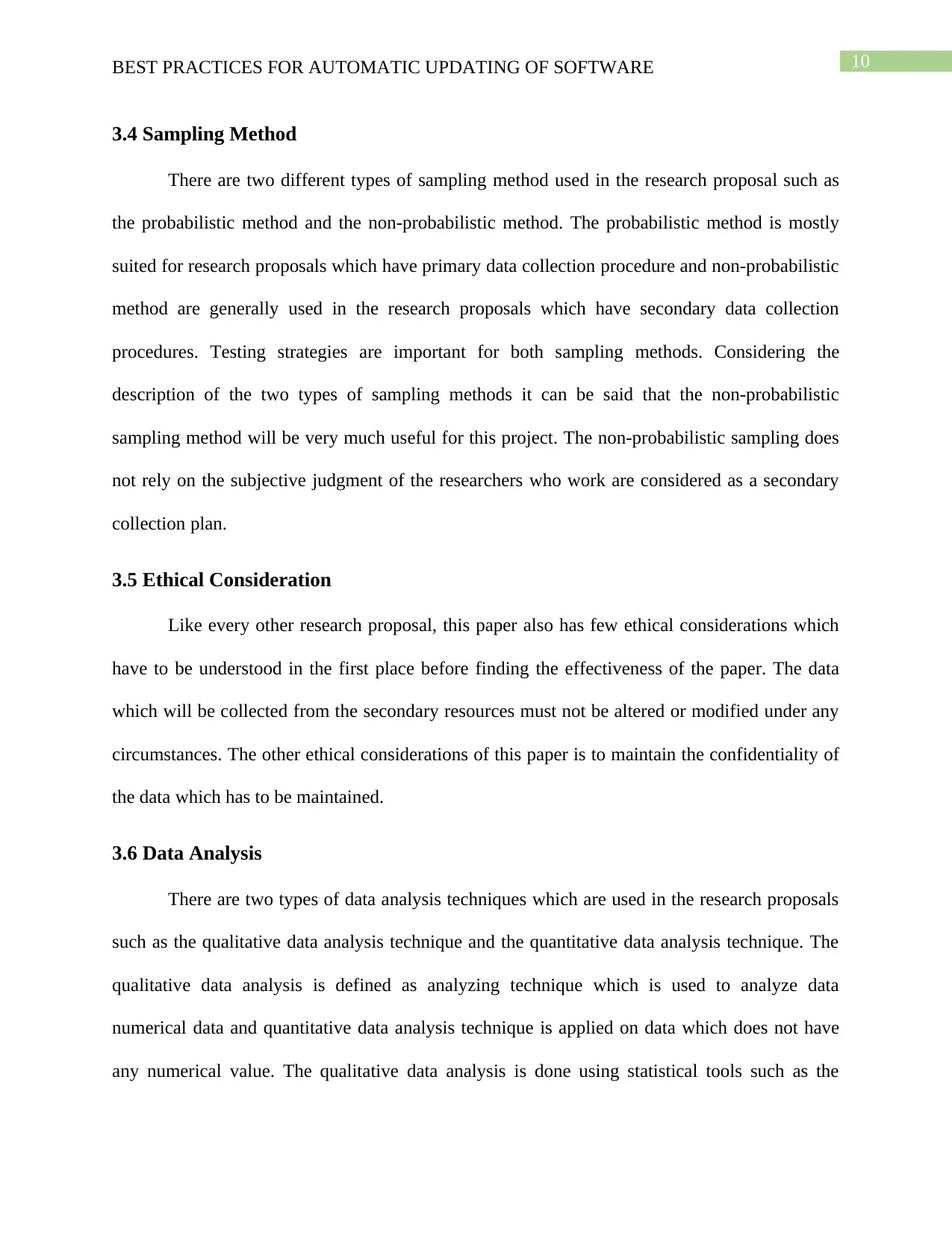
10BEST PRACTICES FOR AUTOMATIC UPDATING OF SOFTWARE
3.4 Sampling Method
There are two different types of sampling method used in the research proposal such as
the probabilistic method and the non-probabilistic method. The probabilistic method is mostly
suited for research proposals which have primary data collection procedure and non-probabilistic
method are generally used in the research proposals which have secondary data collection
procedures. Testing strategies are important for both sampling methods. Considering the
description of the two types of sampling methods it can be said that the non-probabilistic
sampling method will be very much useful for this project. The non-probabilistic sampling does
not rely on the subjective judgment of the researchers who work are considered as a secondary
collection plan.
3.5 Ethical Consideration
Like every other research proposal, this paper also has few ethical considerations which
have to be understood in the first place before finding the effectiveness of the paper. The data
which will be collected from the secondary resources must not be altered or modified under any
circumstances. The other ethical considerations of this paper is to maintain the confidentiality of
the data which has to be maintained.
3.6 Data Analysis
There are two types of data analysis techniques which are used in the research proposals
such as the qualitative data analysis technique and the quantitative data analysis technique. The
qualitative data analysis is defined as analyzing technique which is used to analyze data
numerical data and quantitative data analysis technique is applied on data which does not have
any numerical value. The qualitative data analysis is done using statistical tools such as the
3.4 Sampling Method
There are two different types of sampling method used in the research proposal such as
the probabilistic method and the non-probabilistic method. The probabilistic method is mostly
suited for research proposals which have primary data collection procedure and non-probabilistic
method are generally used in the research proposals which have secondary data collection
procedures. Testing strategies are important for both sampling methods. Considering the
description of the two types of sampling methods it can be said that the non-probabilistic
sampling method will be very much useful for this project. The non-probabilistic sampling does
not rely on the subjective judgment of the researchers who work are considered as a secondary
collection plan.
3.5 Ethical Consideration
Like every other research proposal, this paper also has few ethical considerations which
have to be understood in the first place before finding the effectiveness of the paper. The data
which will be collected from the secondary resources must not be altered or modified under any
circumstances. The other ethical considerations of this paper is to maintain the confidentiality of
the data which has to be maintained.
3.6 Data Analysis
There are two types of data analysis techniques which are used in the research proposals
such as the qualitative data analysis technique and the quantitative data analysis technique. The
qualitative data analysis is defined as analyzing technique which is used to analyze data
numerical data and quantitative data analysis technique is applied on data which does not have
any numerical value. The qualitative data analysis is done using statistical tools such as the
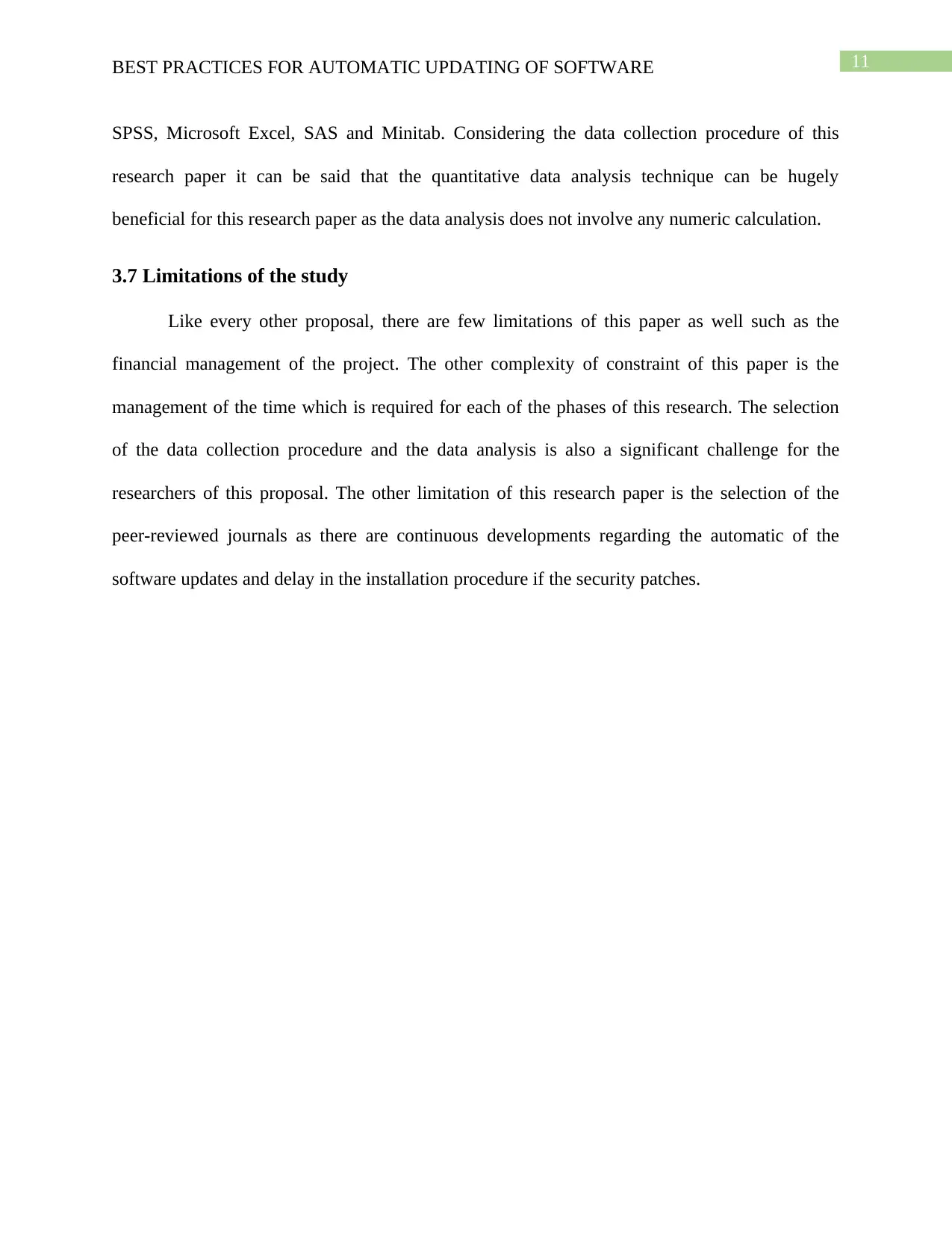
11BEST PRACTICES FOR AUTOMATIC UPDATING OF SOFTWARE
SPSS, Microsoft Excel, SAS and Minitab. Considering the data collection procedure of this
research paper it can be said that the quantitative data analysis technique can be hugely
beneficial for this research paper as the data analysis does not involve any numeric calculation.
3.7 Limitations of the study
Like every other proposal, there are few limitations of this paper as well such as the
financial management of the project. The other complexity of constraint of this paper is the
management of the time which is required for each of the phases of this research. The selection
of the data collection procedure and the data analysis is also a significant challenge for the
researchers of this proposal. The other limitation of this research paper is the selection of the
peer-reviewed journals as there are continuous developments regarding the automatic of the
software updates and delay in the installation procedure if the security patches.
SPSS, Microsoft Excel, SAS and Minitab. Considering the data collection procedure of this
research paper it can be said that the quantitative data analysis technique can be hugely
beneficial for this research paper as the data analysis does not involve any numeric calculation.
3.7 Limitations of the study
Like every other proposal, there are few limitations of this paper as well such as the
financial management of the project. The other complexity of constraint of this paper is the
management of the time which is required for each of the phases of this research. The selection
of the data collection procedure and the data analysis is also a significant challenge for the
researchers of this proposal. The other limitation of this research paper is the selection of the
peer-reviewed journals as there are continuous developments regarding the automatic of the
software updates and delay in the installation procedure if the security patches.
⊘ This is a preview!⊘
Do you want full access?
Subscribe today to unlock all pages.

Trusted by 1+ million students worldwide
1 out of 15
Related Documents
Your All-in-One AI-Powered Toolkit for Academic Success.
+13062052269
info@desklib.com
Available 24*7 on WhatsApp / Email
![[object Object]](/_next/static/media/star-bottom.7253800d.svg)
Unlock your academic potential
Copyright © 2020–2025 A2Z Services. All Rights Reserved. Developed and managed by ZUCOL.





